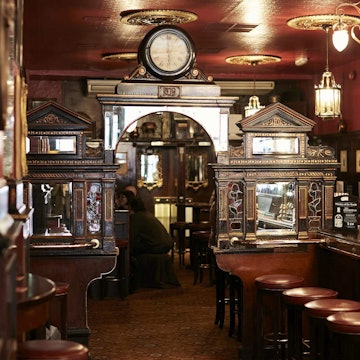

Expect high-quality local produce across Ireland - from fine dining restaurants to street food © Mattia / Stocksy United
These days Ireland‘s food scene is thriving. Talented chefs take advantage of high-quality local produce to produce creative plates that blend traditional food with modern. What’s more, the waters surrounding Ireland are a source of high-quality seafood, which is best enjoyed within view of the ocean.
From gourmet sandwiches to pub grub to Michelin-starred fine dining, there is a memorable meal to be found in Ireland to suit every budget. Here's what to eat and drink in Ireland.
Feast on local seafood on Ireland’s wild Atlantic coast
The dramatic Wild Atlantic Way coastal route winds its way past coastal towns and fishing villages that offer idyllic spots to eat fresh seafood. Here the catch of the day might include lobster, scallops, crab, langoustines and haddock. Options range from takeaway fish and chips to informal beachside shacks to fine-dining restaurants, all with ocean views. Oyster lovers should be sure to stop in Galway, where restaurants serve native flat and Pacific oysters from Galway Bay. The mollusks are further celebrated during Galway City’s annual Oyster Festival.
Where to try it: Vaughan’s Anchor Inn in County Clare serves shellfish on the day it’s caught, including Liscannor Bay lobster and Galway langoustines. Linane’s Lobster Bar, also in County Clare, offers everything from flash lobster platters to more humble fish pie. Fisk Seafood Bar in County Donegal serves casual plates such as fish tacos, prawn banh mi and fish and chips, with views of Downings beach.

Graze on local cheeses and artisan produce at an Irish market
With its famous green pastures, Ireland has a strong farming tradition. Since the 1980s, the Slow Food movement and an emphasis on local produce have been the impetus for the establishment of dozens of farmers’ markets. One of the best is Midleton Farmers Market in County Cork, which was set up by Darina Allen of Ballymaloe Cooking School, along with local farmers.
Market produce to look out for includes local charcuterie and some excellent cheeses from Irish dairies. Among the best are Ardrahan, a flavorsome farmhouse creation with a rich, nutty taste; Corleggy raw-milk goat, sheep, and cows’ cheese; Gubbeen, a superb crumbly, oak-smoked cheese; Durrus, a creamy, fruity cheese; Cashel Blue, a creamy blue cheese from Tipperary; and Cooleeney, a Camembert-style cheese.
Where to try it: First opened in 1788, Cork city’s English Market has the usual fish, meat, fruit, and veg stalls as well as some well-stocked cheese counters. The more adventurous can try the local delicacies: crubeens (pigs’ trotters), drisheen (blood pudding), and tripe (the stomach lining of a sheep or cow). St George’s Market, a beautiful covered market in Belfast, is the place to go for fresh fish from Kilkeel and Portavogie, locally-grown organic fruit and veg, cheese and meat from nearby farms, baked goods, and locally roasted coffee. The covered Milk Market in Limerick has a Saturday farmers’ market.
Treat yourself to a meal at a fine-dining restaurant
At Ireland’s top restaurants, some of Europe’s most skilled chefs make the most of the country’s bountiful local produce to create inventive and technically ambitious dishes. The best chefs place an emphasis on quality ingredients to create carefully designed tasting menus, often with excellent wine pairings. Ireland’s Michelin-starred restaurants aren’t cheap, but some have midweek lunchtime menus that offer a taste of fine dining for a more accessible price.
Where to try it: At Aimsir County Kildare, chef Jordan Bailey has two Michelin stars for his Irish ingredient-led cooking. In Dublin, the 2021 arrival of Finnish chef Mickael Vijanen at Chapter One caused much excitement; the restaurant was promptly awarded two Michelin stars. The tasting menu at Belfast’s EIPIC is a memorable experience. In Cork's Baltimore, try the one-star Michelin Dede for its Turkish take on West Cork produce, or Cork City's Michelin-starred Ichigo Ichie for top-end, seasonal Japanese cuisine.

Try a traditional boxty or a bowl of Irish stew
When it comes to traditional Irish recipes, potatoes are naturally a staple. Colcannon (mashed potato with cabbage) and champ (mashed potato with spring onion) are typical side dishes. A boxty is a Northern Irish starchy potato cake made with a half-and-half mix of cooked mashed potatoes and grated, strained raw potato. Lastly, Irish stew is a warming one-pot dish made with lamb, mutton or beef, potatoes and carrots.
Where to try it: Holohan’s Pantry in Belfast is a good place to try authentic Irish boxtys. Kelly’s Cellars in Belfast and Darkey Kelly’s and Arthur's Pub in Dublin serve bowls of Irish stew.
Sample Ireland’s edible seaweeds
Though edible seaweeds have long been harvested in Ireland, in recent years dulse, kelp and carrageen have contributed to a growing food trend in Ireland: they’re embraced by the health conscious for their nutritional value and by local chefs for their unique taste. Carrageen moss is a reddish seaweed that was traditionally used as a cough remedy, but is now found in savory restaurant dishes and has even appeared as a star ingredient on the dessert menu Ballymaloe House.
Dulse is a purple seaweed that has been harvested in Ireland for more than 1000 years. Traditionally dried and eaten as a snack, dulce is now also used as a seasoning by forward-thinking chefs. Look out for bags of dried dulse in grocers and supermarkets along the Atlantic coast. Abernethy dulse butter is sold at high-end delis and served at many of Ireland’s top restaurants.
Where to try it: A number of seaweed enthusiasts offer seaweed walks and foraging trips along Ireland’s coast, including Prannie Rhatigan’s Irish Seaweed Kitchen in Sligo, The Sea Gardener in Waterford, and Wild Kitchen in County Clare.

Chew the crust of specialty Irish breads
Not content with beloved spuds as a source of carbs, Ireland also has a strong tradition of baking and breadmaking. The most famous is soda bread, which is made with buttermilk and bicarbonate of soda. Guinness is sometimes added, giving the loaf a rich, malty taste. These days the best Irish bakeries produce outstanding artisan sourdough loaves and French-style pastries alongside the classics.
Where to try it: Locals stand in line to buy sourdough from Seagull Bakery in Tramore, County Wexford. In Ballycastle on the north Antrim coast, Ursa Minor has an onsite bakehouse and cafe, and even offers bread-making classes. Éan in Galway is an exceptional bakery and cafe by day and a wine bar by night. In Dublin you'll need to be up early to join the queue for sourdough loaves and pastries at Bread 41.
Experience farm-to-fork and foraged food in rural Ireland
Several family-run Irish farms have embraced sustainable practices and opened their doors to the public, with onsite restaurants and cafes serving homegrown produce. Foraging – once commonplace, then largely forgotten – is undergoing a revival in Ireland. These days it's common to see foraged Irish herbs on restaurant menus, and several farms offer foraging trips to help identify edible wild berries, mushrooms, elderflower, samphire, and sorrel to name just a few.
Where to try it: Make a reservation to dine on organic farm-grown produce and free-range meat at Camus Farm Field Kitchen near Clonakilty in rural County Cork. Specializing in cabrito (male kid goat) meat, free-range rose veal, and wild game, Broughgammon Farm in County Antrim has a farm cafe and shop and offers butchery and foraging courses. Treat yourself to a night at County Cork’s famous Ballymaloe House, where ingredients come fresh from the walled garden and farm, or take a farm-to-fork course at Ballymaloe Cookery School.

Sip Guinness and soak in the atmosphere at an Irish pub
For some, a trip to Ireland means finding out if Guinness really tastes better in its native land and it’s often found on ‘Top 5 things to do in Ireland’ lists. But beyond the famous black stuff, Ireland has an exciting craft beer scene, with microbreweries popping up all over the country. And though whiskey remains the country’s most popular spirit, these days distilleries are branching out to produce craft gins, often infused with local botanicals. Armagh Cider (both alcoholic and non-alcoholic apple juice) is another local tipple to try. Many distilleries and breweries offer worthwhile tours and tastings, but the best way to experience a pint is in an Irish pub, tapping your feet to a trad music session.
Where to try it: Dingle in County Kerry is home to O’Sullivan’s Courthouse as well as Dick Mack’s, reputed to be the best whiskey bar in Ireland. In Dublin, try Grogan's, The Long Hall, or The Oval. Venture a little further out of Dublin's center to The Cobblestone in Smithfield, a traditional pub that's revered for the quality of its Guinness pours and daily trad sessions. In Galway, Tig Chólí has two trad sessions a day.
Cure your hangover with a traditional Irish breakfast
A popular hangover remedy, a traditional Irish breakfast is a hearty plate of fried bacon, sausages, black pudding, white pudding, eggs and tomatoes. For the famous Ulster fry, add potato bread and soda farls. This typical Northern Irish breakfast is sometimes preceded by a bowl of porridge with Bushmills whiskey stirred through, a combination that might set you up for a day in the hills – or send you back to bed.
Where to try it: Head to Wuff, Keoghs Cafe, Brendan's Cafe, Beanhive, or Catherine's Cafe in Dublin. For an Ulster fry, try Maggie May’s in Belfast.
Vegetarians and vegans
Most Irish restaurants now offer several vegetarian and at least one vegan option, which are clearly marked on menus, although vegan food may be more difficult to find in remote, rural areas. Fine-dining restaurants usually request that vegetarian or vegan tasting menus are ordered in advance. Some of the best places to try vegan and vegetarian food in Ireland are restaurants specializing in Indian or Southeast Asian food.
Where to try it: In Dublin, Veginity offers plant-based breakfasts, brunches and dinners inspired by international cuisines. In Belfast, Jumon serves Southeast Asian vegan dumplings, curries, and warming bowls of ramen. For plant-based meals and snacks in Sligo, don’t miss Sweet Beat Cafe.
















